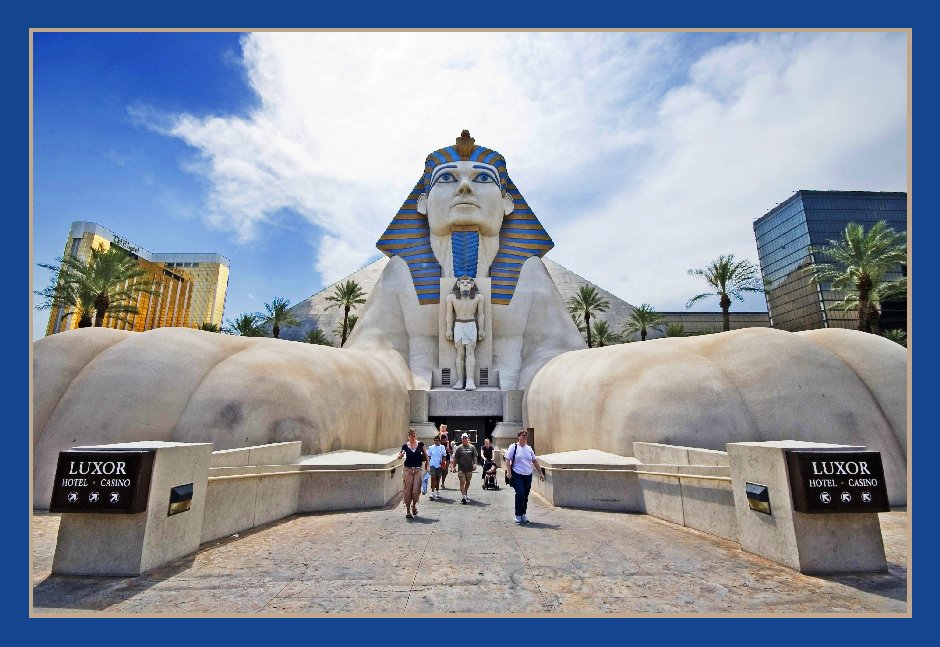The Luxor Hotel Entrance
The Luxor Hotel is a hotel casino located on the famed Las Vegas Strip in Las Vegas, Nevada, United States, and was one of the resort city's first fully-themed megaresorts. Ground was broken for the Luxor in 1991, the same year that construction began on the Treasure Island and the current MGM Grand. It has an Ancient Egyptian motif and contains a total of 4,407 rooms lining the interior walls of a hollow pyramid and contained within two twin ziggurat towers. It opened on October 15, 1993.
It's located on the southern end of the Las Vegas Strip, opposite McCarran International Airport. The resort is flanked by the Mandalay Bay to the south and by the Excalibur to the north; all three are connected by free express and local trams. All three properties were built by Mandalay Resort Group, formerly known as Circus Circus Enterprises. In June 2004, the Mandalay Resort Group was purchased by MGM Mirage, adding this hotel to its vast array of properties on the "Strip". It can be considered the "middle child" of Mandalay's south strip properties, both in terms of age (it opened in 1993; the Excalibur opened in 1990, while Mandalay Bay opened in 1999) and level of luxury.
The Luxor is among the most recognizable hotels on the strip because of its striking design. Designed by renowned hotel architect Veldon Simpson, the main portion of the hotel is a 350-foot-high (106 meters), 30-story pyramid of black glass (in comparison, the Great Pyramid of Giza tops out at 450 ft, or 137 m). The hotel is marked by a large obelisk with the name of the property in lighted letters, while the porte-cochere travels underneath a massive recreation of the Great Sphinx of Giza.
The tip of the pyramid contains a fixed-position spotlight that points directly upward – it is the brightest beam in the world, and is visible from anywhere in the Las Vegas valley at night, and can be seen at flight level from above Los Angeles, California, over 275 miles (440 km) away. In the spring, the bright light attracts huge numbers of moths into the light beam, creating a phenomenon that has been likened to snow. The beam is currently powered by 39 Xenon lamps operating at 7 kilowatts each at an hourly operating cost of $53 (lamps, repairs, and electricity costs). The beam's output is rated at 41.5 gigacandela. Ironically, because the desert air is so clean and dry there is little to deflect the light, the beam's true brightness is lost to all observers except for unfortunate airline pilots flying overhead.
The guest rooms are situated on the outer walls of the pyramid and are reached by riding in so-called "inclinators" that travel along the inner surface of the pyramid at a 39-degree angle. Open hallways leading to the rooms overlook the atrium, which is the largest in the world at 29 million cubic feet (820,000 m³).
The resort has been home to some very popular entertainment attractions in Las Vegas. The main level featured the nightclub, RA, which closed indefinitely on July 22, 2006. From 2000 to 2005, the Luxor Theatre was the home of the enormously popular performance-art show Blue Man Group, which has since moved to The Venetian. On February 15, 2006, the main theatre became the home of the musical Hairspray. The final Hairspray show was on June 11, 2006. No replacement show for the theatre has yet been named. The second level, meanwhile, features additional attractions. An IMAX theatre (the first such theatre in Las Vegas, according to the hotel, which it is not; in 1979, Caesars Palace opened an Omnimax Theater, the precursor to IMAX[1]) shows a rotating selection of films; there is also an IMAX motion simulator ride hosting a variety of rides, including "In Search of the Obelisk," which takes participants into a virtual archeological dig and ReBoot, based on the animated series. The "Atrium Showroom" is home to multiple shows: "Fantasy" (a topless revue), comedian Carrot Top, and the movie/attraction "Pirates 4D". The attractions level also features the "King Tut Museum", an authentic replica of the tomb of Pharaoh Tutankhamun. The reproduction is based directly on the descriptions of the tomb recorded by Howard Carter, who discovered it in 1922.
The hotel is named after the city of Luxor (ancient Thebes) in Egypt, the site of the Valley of the Kings, Karnak and Luxor Temples, and scores of other pharaonic monuments – but no pyramids.
The hotel is commonly viewed as one of the finest examples of 1990s Postmodern architecture, and appeared on the cover of renowned architecture scholar James Steele's book "Architecture Today".
A portion of the 1998 music video Gettin' Jiggy Wit It by Will Smith was shot in the foyer of the hotel.
From Wikipedia, the free encyclopedia










Edina Stojan 13/02/2007 16:05
Schönes Bild!Ich war sogar schon dort. :-)
Liebe Grüße
Edina
Richard Hanauer 11/10/2006 22:01
Klasse, Dank Superweitwinkel fast die beiden Pfoten mit auf Bild gebracht. Das Mandala-Bay liegt fast so in der Kurve wie der schiefe Turm zu Pisa.LG Richard
Martin und Elke (Lagemann-) WENDT 11/10/2006 9:45
Grandioser Blick auf ein grandioses Hotel am Strip. Auch den Rahmen finde ich sehr passend.LG Martin & Elke